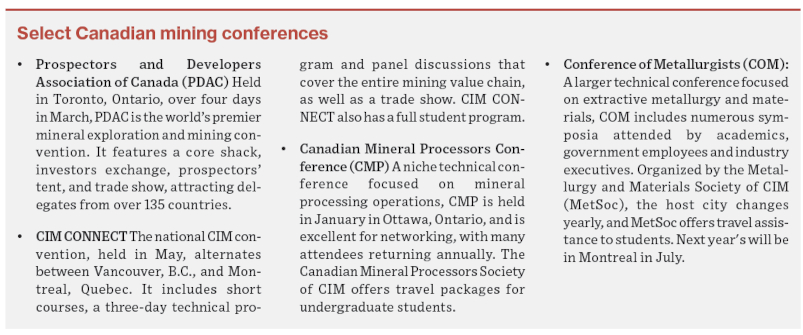Photos courtesy of Ksenia Bilaniuk, Omar Wani and John Forster
For students and young professionals, attending conferences is an excellent way to grow your professional network. You can increase your knowledge by attending talks, engage in meaningful discussions with industry veterans or make an intellectual contribution by delivering a presentation. This guide can help you navigate the many aspects of attending mining industry conferences.
Preparation
Attending a conference can be quite demanding, so preparation is key. The social aspect can be overwhelming as you meet new people constantly, and the early mornings and late nights can lead to overall exhaustion. Start by setting a general goal to guide your activities and expectations. In the professional sphere, meetings with clients or attending specific sessions may fill your schedule. However, having a broader goal of networking and exploring industry options can help you build a manageable itinerary.
The conference program includes the opening ceremony and keynote sessions, technical presentations, panel discussions, mealtimes and trade show hours (if applicable). At larger conferences such as CIM CONNECT, technical presentations run in multiple parallel streams, so reviewing the program’s presentation topics or abstracts before the conference is essential. You can start to build your itinerary by selecting your favourite topics or speakers, providing you with clear destinations and a structure for each day. Be sure to carry a bottle of water to both the technical sessions and the social events and take breaks when needed, as the days can be long.
Dress code
Though business casual is typically the standard at conferences, overdressing is preferable to underdressing. Your attire can reflect your overall goal for the event: dressing to blend in allows for independent exploration, while a more elegant style can project confidence and attract attention. Corporate attendees often wear business dress, such as suit and tie, whereas those from operations or exploration may dress in business casual. Starting with office-appropriate attire gives you the flexibility to add personal touches that people may remember you by. You can choose your daily attire based on your comfort and the crowd you wish to engage with.
Winning networking strategies
Social events at conferences provide attendees the opportunity to make new connections and maintain existing ones. Walking through the trade show can help you meet people and develop lasting contacts.

Networking events can be stressful, especially for newcomers or introverts. Start by making a few connections who can introduce you to others. Always carry business cards and a pen for notes. At your first few conferences, try to collect as many business cards as possible. Sometimes, people may take a picture of your conference badge to reconnect later. Take note that people presenting a business card is often a way to politely end a conversation. If this happens to you, accept the card with thanks and move on.
Though it is common to feel nervous and want to stick together with your classmates, it is crucial to separate from your friends and meet new people. There will be plenty of time to debrief with your fellow students.
When you introduce yourself to someone, give a brief description of your school or work affiliation and interests, which works well as a conversation starter. As you talk to more people, your introduction will become more refined and will boost your confidence. These conversations may naturally lead to discussions about shared interests or even potential internship opportunities.
After the conference, set aside time to follow up with your new connections by adding them on LinkedIn or by sending thank you emails.
Presentations
Delivering a presentation at a conference can be challenging, but with the right preparation, you can excel. Ensure a good night’s sleep the evening before so you are rested and alert. Whether you are presenting in a student poster competition or giving a technical presentation, remember to smile, pause when needed and be direct when responding to questions.
If you are presenting slides in a technical presentation, use graphs and images to illustrate the script of your presentation. Do not read aloud your presentation text from the slides. Employ a laser pointer to guide your audience through the slides. Use your university’s template for a professional appearance. Include slide numbers and consider adding a progress bar. Be sure to time your presentation by rehearsing alone, with colleagues and in front of your supervisor. Summarize your key findings on the concluding slide. During the question and answer period, answer honestly and follow up if needed. Networking is crucial, so bring business cards with your details to hand out afterwards.
Attending conferences is key as you embark on your journey as a young professional. The networking you do as a student serves as a foundation for future prospects as you progress throughout your career.
Ksenia Bilaniuk, BSc mineral engineering, University of Toronto, has worked in mineral processing, metals recycling and refining. She is now pursuing a master’s degree studying grinding media materials and wear at Queen’s University.John Forster, BSc and MSc mining engineering, Queen’s University, and PhD materials science and engineering, University of Toronto, works at EY in the Business Tax Incentives Group, specializing in Scientific Research and Experimental Development claims.Omar Wani, PhD chemical engineering, University of Toronto, is a senior scientist in Vale’s hydrometallurgy group at the Technology and Innovation Centre in Mississauga.





